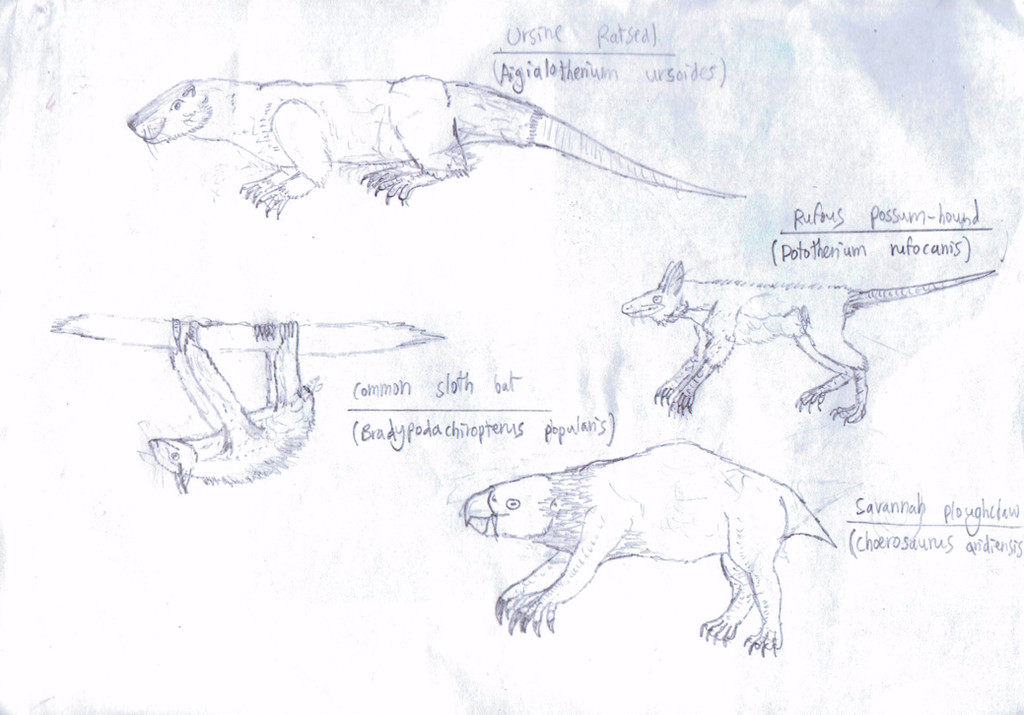HOME | DD
 DesOrages — SIR: Synapsids
DesOrages — SIR: Synapsids

Published: 2014-10-05 19:02:28 +0000 UTC; Views: 1022; Favourites: 16; Downloads: 0
Redirect to original
Description
Clockwise from top left:Ursine Ratseal
(Aigialotherium ursoides)
Habitat: Rivers
Length: 110cm
Height: 50cm
Weight: 16kg
Food: Crustaceans, ammonites, fish, amphibians, small reptiles and mammals
Breeding: 3-4 pups 4 times a year
Lifespan: Unknown
Status: Vulnerable
The Ursine Ratseal is a freshwater relative of the larger, more successful, Coastal Ratseal. Like their relative they are opportunists and are pretty common, although there has been a decline in their numbers in certain areas. The reason for this is unclear, but it's believed to be due to competition from other animals. However the population has remained stable.
Rufous Possum-hound
(Pototherium rufocanis)
Habitat: Grassland-tropical forest
Length: 60cm
Height: 45cm
Weight: 2kg
Food: Small animals, insects, fruit
Breeding: Unknown
Lifespan: Unknown
Status: Common
The Possum-hounds are larger, quadruple relatives of 'Dipodotherium' that are found across the island. They are very adaptable, with 12 known species found in almost every habitat on the island from forest to scrubland to swamp. This species is one of the most common animals.
Savannah Ploughclaw
(Choerosaurus aridiensis)
Habitat: Savannah
Length: 20cm
Height: 10cm
Weight: 18kg (Male) 12kg (Female)
Food: Ferns, grasses, seeds, tubers
Breeding: Unknown
Lifespan: Unknown
Status: Common
The Ploughclaws are burrowing dicynodonts native to the open areas of Skull Island with 7 of the 12 known species living in grassland or savannah. The others are more unique with two native to the forests, one the rainforest and one the bamboo forests. The last species is native to the mountainous areas. In a quirk of evolutionary irony, they aren't decended from primitive terrestrial dicynodonts, but rather come from the arboreal Nutcrackers which went from terrestrial to arboreal, and now back to terrestrial.
Common sloth bat
(Bradypodachiropterus popularis)
Habitat: Montane/cloud forest
Length: 18cm
Weight: 800g
Food: Fruit, seeds, insects
Breeding: Unknown
Lifespan: Unknown
Status: Common
The sloth bats are a group of flightless bats descended from aerwolves, that survived by living in the cloud forests were most aerial predators can't access and most arboreal animals won't go. This has allowed many animals to survive here, whereas they would be outcompeted elsewhere. Sloth bats are primarily herbivorous, but they will take insects occasionally. Friendly animals by nature they will often be seen hanging around scientists camps out of interest (and for the free fruit their deceptively cute faces gain them.)
Related content
Comments: 6

Slothbats are pretty unlikely to evolve on an island full of birds... but... maybe their ancestors were cave-dwelling bats from the Paleocene... Or they could be cryptids... I don't know. XD
👍: 0 ⏩: 1

Well the idea was that they were descended from aerwolves and survived in montane areas alongside other oddities like the hooded clutcher.
👍: 0 ⏩: 0

The possum-hound looks to be a close relative of Dipotherium, I really like it. I'm guessing the dicyndont (if thats what it is) is extinct, or does it just seem larger than it really is?
👍: 0 ⏩: 1

Yes the possum-hounds are dipotherium relatives.
No the plough claws are alive, then drawing isn't to scale so they're smaller than that.
👍: 0 ⏩: 1

Ah, alright. That's great, then!
👍: 0 ⏩: 1

























